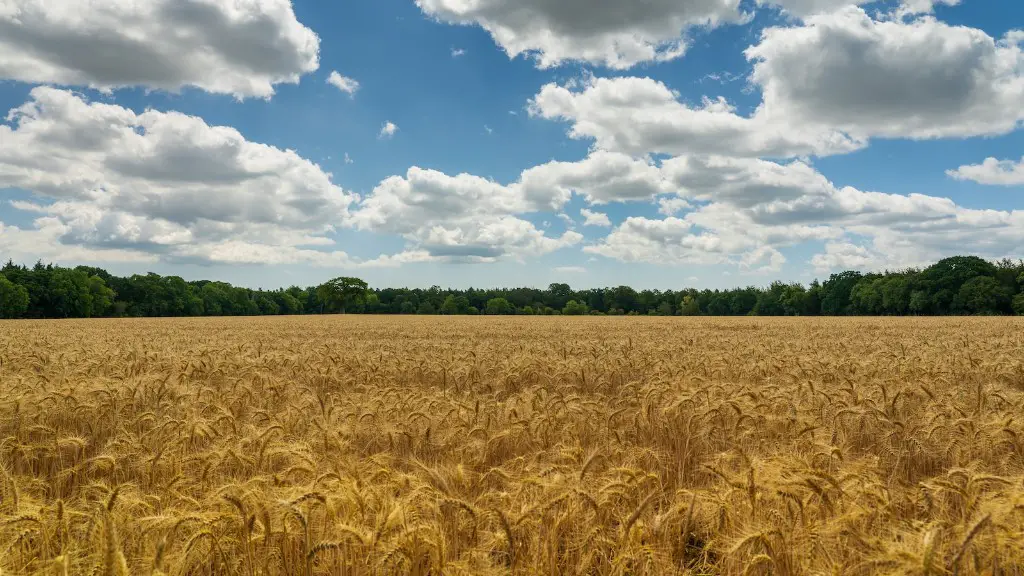The term “GMO” stands for “genetically modified organism.” A GMO is created when a plant or animal’s DNA is changed in a way that would not occur in nature. The first GMO was created in a laboratory in the early 1970s. Since then, there has been a lot of debate about whether or not GMOs are safe. Some people believe that GMO crops are more likely to cause allergies. Others worry that GMOs could create “superweeds” or “superbugs,” which would be difficult to control.
1. One of the main concerns about GMO agriculture is the potential for negative impacts on human health. There is a lack of long-term data on the safety of consuming genetically modified foods, and some people are concerned that there could be unforeseen health consequences of doing so.
2. Another concern is the potential for GMOs to have negative impacts on the environment. There is a fear that the uncontrolled release of genetically modified organisms into the wild could lead to the creation of new, super-resistant pests and weeds, which could damage ecosystems.
3. There is also a social and ethical concern over the use of GMOs in agriculture. Some people feel that it is morally wrong to play with the genetic material of plants and animals, and that GMO crops could threaten the safety of traditional, non-GMO crops.
What are the two main concerns of using GMO in agriculture?
GMO contamination is a real problem that has been well documented. According to the International Journal of Food Contamination, almost 400 cases of GMO contamination occurred between 1997 and 2013 in 63 countries. Part of the problem is the very nature of nature.
GMO crops that are tolerant to herbicides help farmers control weeds without damaging the crops. This is a great way to help farmers reduce the amount of time and effort spent on weed control. These crops also help to improve soil health by reducing the need for tilling.
What are 3 concerns regarding GMOs
There is a great deal of debate surrounding the safety of GMOs for human consumption. One specific concern is the possibility for GMOs to negatively affect human health. This could result from differences in nutritional content, allergic response, or undesired side effects such as toxicity, organ damage, or gene transfer.
There is currently no definitive evidence that GMOs are harmful to human health, but some people remain cautious due to the potential risks. It is important to continue to monitor the safety of GMOs and conduct further research to ensure that they are safe for human consumption.
There are a number of unintended consequences that can result from the use of GE crops. For example, many GE crops are more prone to plant diseases, and some suffer micro-nutrient deficiencies because of subtle changes in soil microbial communities. Additionally, there is mounting evidence that GMOs from GE crops are showing up where they were never used, which can lead to cross-contamination and the development of new, more virulent strains of diseases.
What are the positives and negatives of GMOs in agriculture?
GMO foods are designed to be healthier and cheaper to produce. Advantages of GMO foods include added nutrients, fewer pesticides, and cheaper prices. Disadvantages of GMO foods can be allergic reactions or increased antibiotic resistance.
GMO crops are convenient for farmers because they are resistant to herbicides. However, there are environmental concerns about the use of these crops. A growing number of weeds have developed resistance to Roundup, which is the most commonly used herbicide. This resistance could have a negative impact on the environment, as it would allow weeds to thrive and potentially harm other plants and animals.
What are the negative effects of GMOs on the economy?
The adoption of GMOs into seed markets could lead to farmer dependence on corporations that control the price and supply of seeds. The cost of switching from traditional to genetically modified seeds could also lead to increased inequality among farmers, as poorer smallholders will be left behind by their competitors. This could have serious implications for food security, as farmers would be at the mercy of these companies. It is therefore crucial that measures are put in place to ensure that farmers have access to affordable seeds, and that there is competition in the seed market.
The new “unexpected effects” and health risks posed by genetic engineering are toxicity, genetically engineered foods are inherently unstable, allergic reactions, antibiotic resistance, immuno-suppression, cancer, and loss of nutrition.
What are 3 disadvantages or cons of GMOs
The use of GMOs brings both risks and benefits. On the one hand, GMOs can help to increase crop yields and resistance to pests and disease. On the other hand, the use of GMOs can also lead to changes in the interaction between plants and their environment, which can in turn lead to harm to human or animal health.
There are several cons to genetically modified organisms (GMOs). They might contribute to a rise in allergic reactions, as people may be allergic to the new genes that have been introduced. Additionally, GMOs may contribute to antibiotic resistance, as the antibiotics used to treat them may no longer be effective. Some research has also linked GMOs to cancer, though more research is needed in this area. Finally, very few companies control the entire GMO seed market, which could lead to monopolization and higher prices.
What are some negative impacts of genetically modified crops?
The findings of this research are concerning, as they suggest that the use of GM crops may have a negative impact on the agriculture ecosystem. In particular, the findings indicate that the use of GM crops can result in a net increase in herbicide use, and can also foster the growth of herbicide resistant weeds. These findings highlight the need for further research on the potential impacts of GM crops on the environment, and highlight the need for careful consideration before implementing this technology.
Genetic modification is the process of altering the DNA of an organism to change one or more of its characteristics. This can be done either by introducing new genes from another organism, or by deleting or modifying existing genes.
Genetic modification can have a range of impacts on biodiversity. For example, if a new, genetically modified species is introduced into an environment, it may out-compete existing species and reduce biodiversity. Alternatively, if a genetically modified organism is unable to reproduce, this may also reduce biodiversity.
When considering the potential impacts of genetic modification, it is important to remember that not all changes will be negative. For example, a genetically modified organism may be less susceptible to disease, meaning that it can help to protect other, non-modified organisms from disease.
It is important that any potential impacts of genetic modification are considered before modified organisms are released into the environment. This is done through a process of risk assessment, which is used to identify and assess the risks posed by a particular organism.
What are the disadvantages of GMOs give 2 examples
There are several disadvantages of genetically modified foods. These include:
1. GM crops disrupt the natural process of gene flow because the “better” traits produced from engineering genes can result in the favouring of one organism.
2. The cost of cultivation is increased due to the need for specialised equipment and inputs.
3. It endangers farmers and trade along with the environment as the release of GMOs into the wild can have unpredictable and potentially harmful consequences.
4. There is a risk that GMO crops will cross-pollinate with non-GMO crops, contaminating them with engineered genes.
5. GMO crops are often less nutritious than their non-GMO counterparts and may even be toxic.
6. They may pose serious health risks to both humans and animals.
7. GMO crops are grown using harmful chemicals and pesticides which can contaminate the soil and water.
8. They can have a negative impact on biodiversity as they can lead to the extinction of natural species.
9. GMO crops are often owned by large corporations who have a monopoly on the food supply. This gives them undue power and control over the food we eat.
10. The long-term effects
While there are some advantages to GMO foods, there are also some potential disadvantages that should be considered. Allergic reactions are one potential downside to eating GMO foods. Additionally, the overuse of antibiotics in GMO production can lead to increased antibiotic resistance.
What are the disadvantages of GMOs give 2 examples?
There are a few disadvantages to consider when it comes to genetically modified foods. Firstly, GM crops disrupt the natural process of gene flow because the “better” traits produced from engineering genes can result in the favouring of one organism. This can lead to the extinction of other organisms that don’t have the same favourable traits. Additionally, the cost of cultivating GM crops is often higher than traditional crops, as the process is more complex and expensive. Finally, genetically modified foods can pose a risk to farmers and the environment if they are not properly managed. If GM crops escape into the wild, they can potentially hybridize with other plants, creating superweeds that are difficult to control.
There are a few new “unexpected effects” and health risks posed by genetic engineering:
1. Toxicity: Genetically engineered foods are often unstable and can produce toxins that can be harmful to humans.
2. Allergic Reactions: People can have allergic reactions to genetically engineered foods, which can be severe.
3. Antibiotic Resistance: The overuse of antibiotics in genetically engineered foods can lead to the development of antibiotic-resistant bacteria, which can be difficult to treat.
4. Immuno-suppression: Genetically engineered foods can sometimes suppress the immune system, making people more susceptible to infections and diseases.
5. Cancer: Some studies have shown that genetically engineered foods can increase the risk of cancer.
6. Loss of Nutrition: Genetically engineered foods can sometimes lose vital nutrients during the process, which can lead to deficiencies in the diet.
What are 3 disadvantages or cons of GMOs
The use of GMOs brings with it a number of risks, which include changes in the interaction between plants and their biotic and abiotic environments, potential harm to human or animal health, and alterations in greenhouse gas emissions.
The adoption of GMOs into seed markets could lead to farmer dependence on corporations that control the price and supply of seeds. The cost of switching from traditional to genetically modified seeds could also lead to increased inequality among farmers, as poorer smallholders will be left behind by their competitors. This could ultimately lead to less food security and sovereignty for farmers, as they would be at the mercy of these large seed companies.
Warp Up
There are a few key concerns about GMO agriculture. One is that GMOs may contribute to the development of antibiotic-resistant bacteria. Another concern is that GMOs may have negative effects on the environment, for example by harming pollinators. Additionally, some people worry about the potential health effects of consuming GMOs.
There are a few primary concerns about GMO agriculture. The first is that GMOs may have negative impacts on human health. There is also concern that GMOs may harm the environment, and that they may lead to the development of antibiotic-resistant bacteria.





